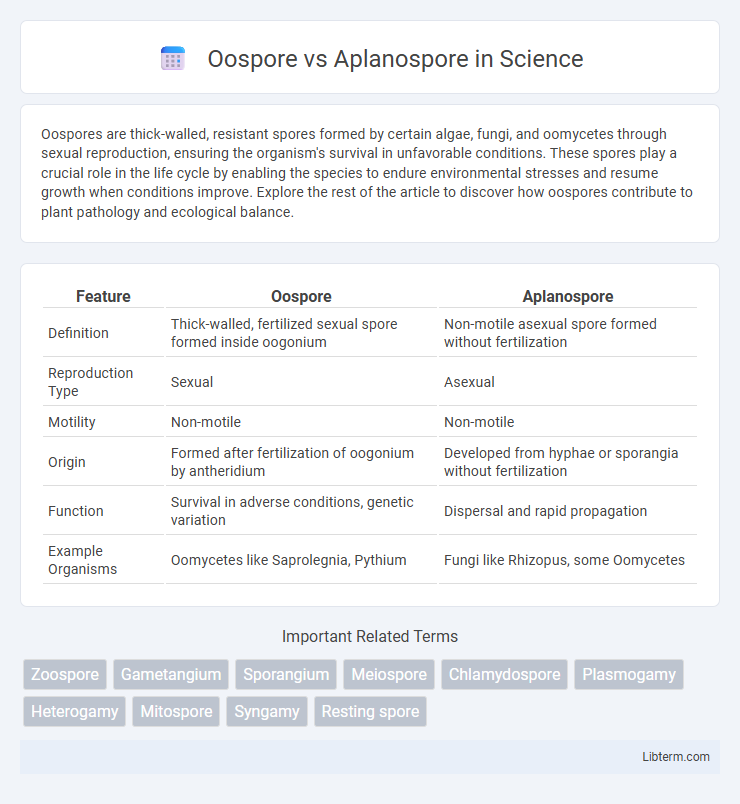Oospores are thick-walled, resistant spores formed by certain algae, fungi, and oomycetes through sexual reproduction, ensuring the organism's survival in unfavorable conditions. These spores play a crucial role in the life cycle by enabling the species to endure environmental stresses and resume growth when conditions improve. Explore the rest of the article to discover how oospores contribute to plant pathology and ecological balance.
Table of Comparison
| Feature | Oospore | Aplanospore |
|---|---|---|
| Definition | Thick-walled, fertilized sexual spore formed inside oogonium | Non-motile asexual spore formed without fertilization |
| Reproduction Type | Sexual | Asexual |
| Motility | Non-motile | Non-motile |
| Origin | Formed after fertilization of oogonium by antheridium | Developed from hyphae or sporangia without fertilization |
| Function | Survival in adverse conditions, genetic variation | Dispersal and rapid propagation |
| Example Organisms | Oomycetes like Saprolegnia, Pythium | Fungi like Rhizopus, some Oomycetes |
Introduction to Oospores and Aplanospores
Oospores are thick-walled, sexually produced spores found in certain algae and fungi, serving as a durable survival structure in unfavorable conditions. Aplanospores are non-motile, asexual spores that facilitate propagation without the need for water or flagella, commonly observed in fungi like species of Aspergillus and Penicillium. Both spore types play crucial roles in the life cycle and environmental adaptation of various microorganisms.
Definition of Oospore
Oospore is a thick-walled, sexual spore formed by the fusion of two gametes in Oomycetes, serving as a durable survival structure during unfavorable conditions. Unlike aplanospores, which are non-motile asexual spores used for dispersal, oospores result from sexual reproduction and contribute to genetic variation. The robust oospore helps sustain the organism through environmental stresses until conditions support germination and growth.
Definition of Aplanospore
Aplanospore is a non-motile, asexual spore produced within the parent cell, often formed by algae, fungi, and some protozoa, serving as a means of survival and reproduction under unfavorable conditions. Unlike oospores, which are thick-walled, sexual spores resulting from the fusion of gametes, aplanospores do not involve sexual reproduction. Oospores function as resilient resting spores in species such as oomycetes, while aplanospores enable rapid propagation without requiring water or motility.
Structural Differences
Oospores are thick-walled, sexual spores formed inside an oogonium through the fertilization of an egg cell by motile male gametes, exhibiting a resistant, durable structure for survival under adverse conditions. Aplanospores are non-motile, asexual spores characterized by their smooth, thin to moderately thick walls and lack of flagella, allowing them to disperse through water or air without active movement. The structural distinction lies primarily in oospores' complex, multilayered, and robust wall designed for dormancy, contrasting with the simpler, less resilient wall of aplanospores meant for rapid propagation.
Formation Mechanisms
Oospores form through sexual reproduction by the fusion of an oogonium and an antheridium, resulting in a thick-walled, dormant spore that ensures survival under adverse conditions. Aplanospores develop asexually within specialized cells, producing non-motile, thick-walled spores that allow for dispersion without the need for fertilization. The key difference lies in oospores arising from gamete fusion, while aplanospores originate from mitotic division.
Reproductive Significance
Oospores serve as thick-walled, durable sexual spores that ensure genetic diversity and enhance survival under adverse environmental conditions for many algae and fungi. Aplanospores function as asexual, non-motile spores that facilitate rapid colonization and propagation in stable environments by bypassing the need for mating. The reproductive significance of oospores lies in long-term survival and genetic recombination, while aplanospores prioritize quick proliferation and spatial expansion.
Biological Functions
Oospores function as thick-walled, resistant sexual spores that ensure survival under adverse environmental conditions and facilitate genetic recombination in algae, fungi, and oomycetes. Aplanospores are non-motile, asexual spores that primarily serve for rapid propagation and colonization in fungi and certain protists. Both spore types play crucial roles in life cycle continuation, with oospores emphasizing durability and genetic diversity while aplanospores focus on efficient dispersal and growth.
Occurrence in Organisms
Oospores predominantly occur in oomycetes, such as species in the genera *Phytophthora* and *Pythium*, where they function as thick-walled, sexual spores formed after fertilization. Aplanospores are typically found in fungi and some algae, representing non-motile asexual spores produced under unfavorable environmental conditions. The occurrence of oospores is closely linked to sexual reproduction in water molds, while aplanospores are common in asexual reproduction across various fungal taxa.
Ecological Importance
Oospores serve as thick-walled, durable spores in water molds, enabling survival in harsh conditions and facilitating seasonal regeneration, playing a crucial role in ecosystems' nutrient cycling. Aplanospores, non-motile asexual spores, contribute to rapid population expansion and colonization in aquatic habitats, influencing microbial community dynamics. Both spore types are vital for maintaining ecological balance and supporting the decomposition processes in freshwater and soil environments.
Key Differences: Oospore vs Aplanospore
Oospore is a thick-walled sexually produced spore formed by the fusion of two gametes, primarily found in fungi like Oomycetes, providing resistance and genetic recombination. Aplanospore, on the other hand, is an asexual, non-motile spore that develops without gamete fusion, common in certain algae and fungi, facilitating rapid colonization. The key difference lies in their mode of formation--sexual versus asexual reproduction--and their structural adaptations for survival and dispersal.
Oospore Infographic

 libterm.com
libterm.com